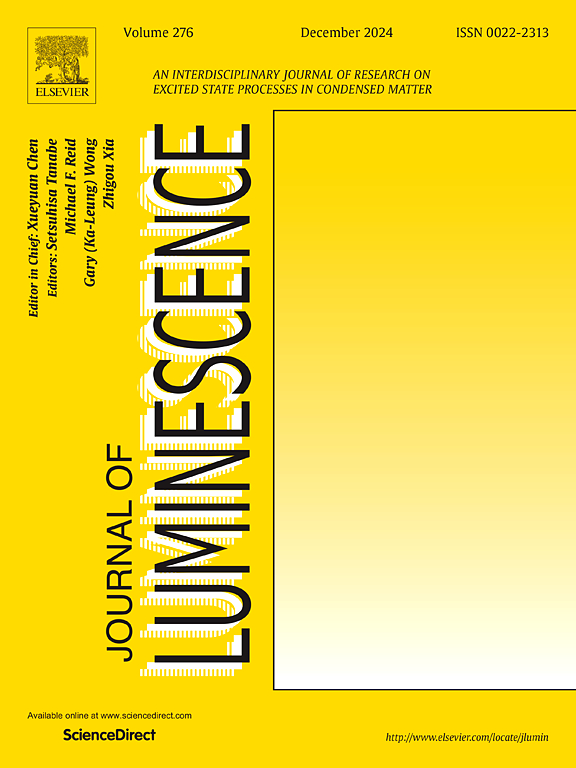揭示卤素离子交换反应动力学对钙钛矿CsPbBrx(Cl或I)3-x纳米晶稳定性的影响机理
IF 3.3
3区 物理与天体物理
Q2 OPTICS
引用次数: 0
摘要
卤素离子交换反应可对铅卤化钙钛矿纳米晶体(NCs)的电子结构进行定制,使其在紫外-可见-近红外窗口内实现可调谐光致发光(PL),这被认为是调控钙钛矿化学成分最有效、最便捷的后处理方法。然而,经过这种离子交换后处理的钙钛矿NCs通常不稳定,交换反应动力学如何影响钙钛矿NCs稳定性的机理尚未得到很好的证明。在本研究中,我们证明了Cl在CsPbBr3 NCs中的扩散限制过程依赖于溶液中Cl的浓度,Br/Cl离子交换反应相对温和有序,从而生成了稳定的蓝色CsPbBrxCl3-x NCs。在CsPbBrxI3-x红色NCs中发生了快速合金工艺与卤素偏析的竞争,卤素偏析是NCs降解的主要原因,反应后呈现出淬灭的PL发射。本文提出了卤素交换反应动力学与钙钛矿NCs稳定性之间的相互关系,有助于理解和进一步提高钙钛矿及其光电器件的稳定性。本文章由计算机程序翻译,如有差异,请以英文原文为准。

Unveiling the influence mechanisms of halogen ion exchange reaction kinetic on the stability of the perovskite CsPbBrx(Cl or I)3-x nanocrystals
The electronic structure of lead-halide perovskite nanocrystals (NCs) could be tailored to enable the tunable photoluminescence (PL) in the window from ultraviolet–visible–near infrared by halogen ion exchange reaction, which has been considered as the most effective and convenient post-treatment method for manipulating the chemical composition of the perovskite. However, the perovskite NCs with such post-treatment of ion exchange are generally not stable, and the mechanism of how the exchange reaction kinetic influences the stability of perovskite NCs has not been well demonstrated. In this work, we show that the Cl diffusion limited process in CsPbBr3 NCs is dependent on the Cl concentration in the solution, the Br/Cl ion exchange reaction is relatively gentle and ordered, which give rises a stable blue CsPbBrxCl3-x NCs. The competition between rapid alloy process and halogen segregation occurs in the CsPbBrxI3-x red NCs, the halogen segregation is responsible of the NCs degradation showing quenched PL emission after reaction. This work presents a view of interrelationship between reaction kinetic of halogen exchange and the stability of the perovskite NCs, which facilitates to understand and further improve the stability of perovskite and its optoelectronic devices.
求助全文
通过发布文献求助,成功后即可免费获取论文全文。
去求助
来源期刊

Journal of Luminescence
物理-光学
CiteScore
6.70
自引率
13.90%
发文量
850
审稿时长
3.8 months
期刊介绍:
The purpose of the Journal of Luminescence is to provide a means of communication between scientists in different disciplines who share a common interest in the electronic excited states of molecular, ionic and covalent systems, whether crystalline, amorphous, or liquid.
We invite original papers and reviews on such subjects as: exciton and polariton dynamics, dynamics of localized excited states, energy and charge transport in ordered and disordered systems, radiative and non-radiative recombination, relaxation processes, vibronic interactions in electronic excited states, photochemistry in condensed systems, excited state resonance, double resonance, spin dynamics, selective excitation spectroscopy, hole burning, coherent processes in excited states, (e.g. coherent optical transients, photon echoes, transient gratings), multiphoton processes, optical bistability, photochromism, and new techniques for the study of excited states. This list is not intended to be exhaustive. Papers in the traditional areas of optical spectroscopy (absorption, MCD, luminescence, Raman scattering) are welcome. Papers on applications (phosphors, scintillators, electro- and cathodo-luminescence, radiography, bioimaging, solar energy, energy conversion, etc.) are also welcome if they present results of scientific, rather than only technological interest. However, papers containing purely theoretical results, not related to phenomena in the excited states, as well as papers using luminescence spectroscopy to perform routine analytical chemistry or biochemistry procedures, are outside the scope of the journal. Some exceptions will be possible at the discretion of the editors.
 求助内容:
求助内容: 应助结果提醒方式:
应助结果提醒方式:


